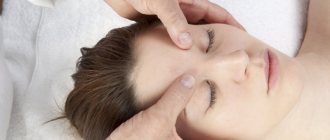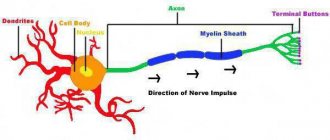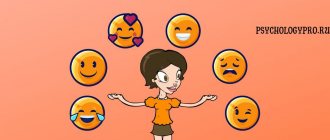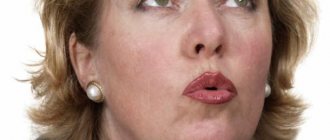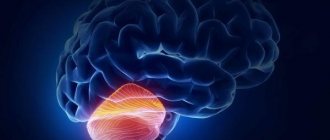Self-regulation is an important part of the human psyche, and it is useful for every person to master it. It's about managing your mental and emotional state, and this is undoubtedly a very useful quality. By influencing oneself with mental images, controlling breathing, or using other techniques, a person can “come to his senses” quite quickly. So how do you master self-regulation?
What is self-regulation
Let us take a closer look at the concept of “self-regulation” in psychology and pedagogy.
In psychology
Self-regulation means assessing the situation and adjusting one’s own activity directly by the individual. As a result, the results of the action are adjusted. There is voluntary and involuntary self-regulation.
Voluntary form is characterized by conscious control of behavior in order to achieve the desired. With the help of conscious self-regulation, a person develops individuality. Involuntary is more aimed at survival and self-preservation - subconscious defense mechanisms are triggered.
The norm is considered to be a situation where self-regulation is formed and develops in parallel with personal maturation. If there is no personal development, a person does not learn to bear responsibility, then the situation worsens. The development of self-regulation is impossible without personal growth.
In adulthood, self-regulation helps subordinate emotions to intellect, but in old age the balance shifts again towards emotions.
Aspects influencing self-regulation
:
- external environmental conditions;
- personality traits;
- features of the relationship between the individual and the environment;
- goals of activity.
Simply put, self-regulation is socially acceptable methods of dealing with feelings and emotions, as well as accepting norms of behavior, respect for others, and adequate reactions.
In pedagogy
Teachers often have to be in stressful situations related to children, their parents, presentation of new material, and so on. It is especially important for a teacher to master relaxation and mental self-regulation methods. One of them can be called autogenic training - work with self-hypnosis and self-tuning of the psyche, based on the use of the relaxation process. It becomes easier to manage emotions and restore performance.
How to master auto-training
?
- learn self-hypnosis
: focus attention on a separate object (your entire body or its individual components); - visualize
the contents of self-hypnosis formulas as clearly as possible (“my hands are relaxed, I am calm”, etc.); - periodically achieve complete relaxation of your arms, legs, and torso
. Relaxation of skeletal muscles and a low level of wakefulness in the brain have a direct connection with calming the nervous system and reducing emotional tension.
Teachers are advised to pay special attention to self-regulation and influence themselves with effective language. There are many auto-training methods that help you develop the necessary skills. Some educational institutions include psychological relief rooms, where the teacher has the opportunity to relieve tension caused by a certain irritant. Popular methods of pedagogical self-regulation: bibliotherapy, music therapy, occupational therapy, cultivating optimism, and so on.
Components and levels of self-regulation
Self-regulation includes 2 elements:
- Self-control. Sometimes it is the need to give up something pleasant or desirable for other goals. The beginnings of self-control appear as early as 2 years of age.
- The second element is consent. We agree on what we can and cannot do. After 7 years of age, a person normally already has formed consent.
For the development of conscious self-regulation, it is important to have the following personality traits:
- responsibility,
- perseverance,
- flexibility,
- reliability,
- independence.
Self-regulation is closely related to the will of the individual. To manage his behavior and psyche, a person needs to build new motives and motivations.
Therefore, self-regulation can be divided into 2 levels: operational-technical and motivational.
- The first involves the conscious organization of action using available means.
- The second level is responsible for organizing the direction of all activities through the conscious management of the emotions and needs of the individual.
The mechanism of self-regulation is life choice. It turns on when you need to change not circumstances, but yourself.
Self-awareness (an individual’s awareness of his own characteristics) is the basis of self-regulation. Values, self-concept, self-esteem and level of aspirations are the initial conditions for the operation of the self-regulation mechanism.
Mental characteristics and properties of temperament and character play a significant role in the development of self-regulation. But without motive and personal meaning it doesn’t work. Conscious regulation is always personally significant.
Theories of mental self-regulation
Let's consider popular theories of self-regulation in psychology.
System activity theory
The author of the theory is L. G. Dikaya. The concept assumes that psychological self-regulation is considered as a system and as an activity related to the individual’s professional environment and adaptation.
As a system, self-regulation can be considered in the context of the individual’s transition from unconsciousness to conscious and automatic forms.
The author has identified several levels
:
- Involuntary level
. The basis of regulation is the processes of excitation and inhibition, as well as nonspecific activity in the psyche. These reactions are uncontrollable and their duration is short. - Arbitrary level
. The need for regulation occurs in difficult life situations, emotions are involved. The reaction becomes in semi-conscious ways: increased speech and motor activity, holding your breath, muscle tension. Usually a person tries to automatically awaken himself and does not take many changes into account. - Conscious regulation
. A person becomes aware of fatigue, discomfort, tension. He can also analyze the level of severity of his condition. He decides to change the situation, and here such aspects as self-control, will, psychophysical exercises, and auto-training come into play. - Purposeful conscious level
. Clearly realizing that this can no longer continue, and the time has come to choose between psychological self-regulation, the individual, wanting to eliminate the discomfort, begins to re-prioritize and evaluate his own needs and motives. As a result, a decision is made to temporarily abandon activities and take care of one’s condition. If this opportunity is not provided, then a decision is made to continue activity in discomfort or to balance activity and self-regulation. Next comes a series of such aspects: self-persuasion, introspection, self-hypnosis, self-programming. Changes occur not only at the cognitive level, but also at the personal level.
System-functional theory
The author of the theory was A. O. Prokhorov, who considered psychological self-regulation as a transition from one mental state to another, associated with ideas about the desired mood. A conscious image helps to activate self-control and corresponding motives.
Having resorted to conscious methods to achieve what he wants, a person usually uses different methods and goes through more than one intermediate state. Subsequently, a functional structure of personality self-regulation is formed - a conscious reaction to conflict situations.
A. O. Prokhorov noted that self-regulation is a transition from one state to another, which is achieved through the connection of mental properties and internal switching of work.
The more conscious the consciousness, the more successful the regulation. Also important is the clarity of formation of the desired image and the realism of perceptions and sensations. The current position is analyzed using bodily sensations, breathing, perception of time and space.
Test of your self-regulation abilities
Give yourself a plus next to each applicable statement. The more of them, the better you can control yourself.
- You adhere to your own values and do not give in to provocations;
- You can bring yourself back to your senses when you are upset or depressed;
- You don’t get lost in difficult situations and are used to relying on yourself;
- You know how to adapt to circumstances;
- When things don’t go according to plan, don’t give up and keep moving towards your goal;
- You see the good in others, don't judge by first impressions;
- Do you prefer open communication, without pitfalls;
- Attentive and patient with the interlocutor;
- You can easily control outbursts of anger and irritation;
- You think of problems as opportunities;
- You strive to finish what you started;
- Don't avoid responsibility;
- If necessary, I am ready to take the situation under my personal control.
Kinds
Modern practical psychology successfully uses different types of mental self-regulation to normalize the internal state of the individual.
Popular types include
:
- autogenic training, based on the use of special self-hypnosis formulas that allow you to influence body processes;
- self-education through certain exercises;
- biofeedback;
- meditation;
- visualization.
The conscious use of certain types of self-regulation begins at approximately three years of age.
- At 3-4 years of age,
involuntary motor and speech methods of self-regulation are predominant - for every 7-8 involuntary ones there is so far only one voluntary one. - Children 4-5 years old
learn emotional control through play. Involuntary methods still predominate: four to one. - By the age of 5-6 years
, the proportions are equalized one to one, and now children actively use imagination, memory, thinking and speech. - From the age of 6-7 years
you can already talk about self-correction and self-control. The proportions have changed dramatically: for every 3-4 voluntary methods of self-regulation, there is only one involuntary one. - From the age of 8
and throughout the entire period of growing up, an individual improves his methods, adopting them from those around him. - At the age of 20-40 years
, the type of self-regulation chosen has a direct dependence on human activity. Conscious volitional methods are mainly used. - A person of 40-60 years old
retains manipulations with attention, but they are gradually replaced by passive rest and bibliotherapy. - After 60 years
, passive relaxation, communication, reflection and comprehension are predominant.
Features of self-regulation by gender
Women are more susceptible to fear, irritation, anxiety, and fatigue than men. Men are more likely to experience loneliness, apathy and depression.
The methods of self-regulation used by men and women also differ. The men's arsenal of methods is much wider than the women's. The difference in self-regulation between the sexes is due to several factors:
- historically established differentiation of social roles;
- differences in the upbringing of girls and boys;
- specifics of work;
- cultural gender stereotypes.
But the biggest influence is the difference in the psychophysiology of men and women.
Women's methods of self-regulation are more of a social nature, while men's are biological. The direction of male self-regulation is internal (directed inward), while female self-regulation is external (directed externally).
In addition to gender, the characteristics of self-regulation are associated with age, mental and personal development of a person.
Functions
It is important to understand the basic functions of self-regulation in psychology in order to understand its value. It changes mental activity, which allows the individual to achieve balance and harmony.
In turn, this provides us with such significant advantages
:
- Containing the first negative impulses in a conflict situation
. A person who masters self-regulation methods is able to nip conflict in the bud. - Rational analysis of the situation at a time of crisis or stress
. A very important quality that improves the life of any person and those around him. - Accumulation of strength
. However, it is important not only to accumulate strength, but also to restore it, and self-regulation does an excellent job of this. - Confronting adversity
. The subsequent quality of our life and harmony in relationships with others depends on how we confront problems.
Direct and indirect methods
Direct methods
Direct methods of influencing the psyche include music. Yes, its effectiveness was experimentally proven back in the 19th century by V. M. Bekhterev, although intuitively music has been used for treatment purposes since ancient times.
The second method is libropsychotherapy, or treatment with special literature. Books draw a person into a fictional world, make them experience the emotions of the characters and distract them from their own experiences.
Indirect methods
- Work and sports are the most effective indirect methods. They provide relaxation, charge with positivity and distract from worries.
- Imagotherapy, or role-playing games, is a method of correcting a condition through personal changes. In the process, new character traits are formed, the personality structure and the experience of problems change.
- Suggestion and self-hypnosis. The spoken words are not criticized, but are accepted by default and become a person’s internal attitude, which corrects his activity.
As you may have noticed, these methods do not necessarily relate to self-regulation, but there are methods exclusively for independent use that develop the ability to self-government. For example, autogenic training. You will also learn about this from the article, but a little later.
Popular methods of self-regulation
Let's look at common methods of self-regulation.
Relaxation
Everyone determines for themselves which method of relaxation is most suitable for them within the framework of self-regulation. The main goal of this method is to achieve internal harmony, relieve muscle tension and tension, and master muscle control.
Meditation
Thanks to meditation, we learn to concentrate, relax our attention and increase it. The main goal of meditation is to relieve emotional stress and distract from depressing thoughts. If you need to collect yourself and calm down, breathing techniques are often used. You can use the technique of distraction - think about anything except the annoying circumstance.
Desensitization
When desensitization is effective: intentional passivity, presentation of successful behavior, neutral attitude towards harmful factors using self-suggestion.
Autogenic training
Any auto-training is based on the relaxation mechanism. You master muscle relaxation techniques, develop the skills of sensing cold and heat in the body, increase your volitional attitude and focus on monitoring the state of the body. The main goal of auto-training is to relieve emotional and muscle tension, achieve a completely relaxed state for the development of volition.
Topic 2. Methods and techniques of psychological self-regulation in the system of stress prevention
Methods and techniques of psychological self-regulation in the system of preventing professional stress.
The profession of a firefighter is associated with various stress factors. The uncertainty of the current situation, the constant expectation of danger, the need for continuous logical and psychological analysis of rapidly changing situations, the intense work of attention, and working with human grief have a powerful and ambiguous effect on the human psyche, requiring the mobilization of all his physical and mental capabilities to effectively solve the problems at hand.
A firefighter performs his professional duties while being in constant contact with people in stressful situations, colleagues, often with minimal work experience, representatives of interacting bodies and services, and journalists. Human communication in such situations often tests the psyche “to its strength”, creating conditions for the emergence of tension and disruption of emotional balance. All this often leads to dissipation of attention, transferring it to internal processes and states, reducing volitional readiness for immediate action and negatively affects the performance of official tasks.
People have learned to manage their body hygiene, muscle function, and thought processes more or less tolerably; however, many remain essentially powerless in the area of regulating their own emotions and passions. A person’s inability to regulate his moods negatively affects not only relationships with others (conflicts, incompatibility, hostility, etc.), but also the quality of performance of professional duties. A long stay in the grip of negative emotional states (anxiety, expectations of the unknown, guilt, dissatisfaction, anger, etc.), the inability to reduce the severity of the experience of adverse effects is also fraught with the fact that it has a destructive effect on the body, physical and mental state.
Even in ancient times, a connection was noticed between a person’s emotions and his physical condition. It was believed, for example, that the need to constantly suppress emotions destroys the heart; envy and anger affect the digestive organs; sadness, despondency, melancholy - accelerate aging; constant fear damages the thyroid gland; uncontrollable grief leads to diabetes. And prolonged nervous stress can destroy the strongest organism, so it is extremely important for every rescuer to be able to promptly notice the impact of stress factors, quickly and effectively “discharge” the resulting mental tension, relieve a negative emotional state, and reduce pain. No less important in his activities is the ability to instantly carry out volitional mobilization, to bring together all physical and mental forces. This can be achieved using methods of mental self-regulation.
For thousands of years, people have been looking for effective ways to influence themselves. Particularly valuable experience in this regard has been accumulated in Eastern martial arts schools. Here, the main condition for an adequate response to rapid changes in the situation, adaptation in any extreme situation, achievement, preservation of physical health, and rapid psychocorrection was considered to be the ability of a person to maintain his psyche in a state of “spirit like water” and “spirit like the moon.”
According to the masters, “a spirit like water,” like a calm surface, is capable of giving an exact mirror image of any object. But as soon as the wind blows, small ripples will destroy the reflection and distort it beyond recognition. Once a person succumbs to fear, anger, and excitement, he will lose the ability to clearly control the situation and will find himself defenseless in the face of danger.
Martial arts experts claimed that the “moon-like spirit” reveals any enemy actions, any gap in his defense. But behind the rolling clouds the moonlight dims. Excessive emotionality leads to loss of composure and self-control, giving rise to inappropriate situations of action.
The ideal state of a fighter was considered to be an “empty consciousness”, in which the warrior “does not expect anything and is ready for anything, at every moment of what is happening he is not connected with the past, does not depend on the future and lives only in the present, perceiving it with his whole being.” For a person with an “empty consciousness,” personal well-being and mental balance are elevated to an understanding of “natural harmony and justice,” and his actions take place, as it were, “beyond good and evil,” “life and death.”
Various methods have been used to achieve this state of mind. Among them, complex techniques were used: auto-training, active meditation, as well as fairly simple breathing techniques, gymnastics, and psychotechnical exercises. Many of them are still widely practiced today in the system of psychophysical training in the martial arts schools of Kyoko-shin-kai, Choi, Aikido, etc.
Warriors in ancient Sparta and in some Indian tribes of North America underwent a good school of mental self-regulation. A unique system of self-control has been developed in the teachings of yogis.
It is known that a person is able to influence himself using three ways:
a) changes in skeletal muscle tone and respiration;
b) active inclusion of ideas and sensory images;
c) use of the programming and regulatory role of the word.
WAYS TO REGULATE EMOTIONAL STATES
The first self-influence technique we will consider is breathing control.
Breathing is not only the most important function of the body, but also an effective means of influencing muscle tone and emotional means of influencing the centers of the brain.
Slow and deep breathing reduces the excitability of nerve centers and promotes muscle relaxation.
Frequent breathing, on the contrary, ensures a high level of body activity.
Most people in everyday life use only shallow breathing, when only the tops of the lungs are filled. Full breathing, as stated in the “pranayama” section of the teaching on breathing, includes filling the lower, middle and upper parts of the lungs. By changing the type, rhythm of breathing, the duration of inhalation and exhalation, a person can influence many functions, including mental ones.
To start mastering, you can master 2 types of breathing: lower (abdominal) and upper (clavicular).
Lower breathing is used when it is necessary to overcome excessive anxiety, overcome anxiety and irritability, and relax as much as possible for quick and effective rest. Lower breathing is the most productive, because the largest number of pulmonary vesicles (alveoli) are located in the lower parts of the lungs.
Abdominal breathing is performed as follows: while sitting or standing, you need to relieve tension from the muscles and focus your attention on breathing. Then 4 stages of a single breathing cycle are performed, accompanied by an internal count to facilitate learning.
At the count of 1-2-3-4, a slow inhalation is carried out, while the stomach protrudes forward, the abdominal muscles are relaxed, and the chest is motionless. Then, for the next 4 counts, you hold your breath and exhale smoothly for 6 counts, accompanied by pulling the abdominal muscles towards the spine. Before the next inhalation there is a pause of 2-4 counts. It should be remembered that you need to breathe only through your nose and as smoothly as if a fluff was hanging in front of your nose at a distance of 1 - 15 cm, then it should not flutter. After just 3-5 minutes of such breathing, you will notice that your state has become noticeably calmer and more balanced.
If you need to cheer up after monotonous work, relieve fatigue, and prepare for vigorous activity, then upper (clavicular) breathing is recommended.
It is carried out by vigorously taking a deep breath through the nose, raising the shoulders and exhaling sharply through the mouth. In this case, there are no pauses between inhalation and exhalation. After just a few cycles of this breathing, you will feel a feeling of “goosebumps” on your back, freshness, and a surge of vigor.
The following exercises can be used:
1. "Calming breathing."
In the starting position, standing or sitting, take a full breath. Then, holding your breath, imagine a circle and slowly exhale into it. Repeat this technique four times. After this, inhale again, imagine a triangle and exhale into it three times. Then exhale into the square twice in the same way. After completing these procedures, you will definitely feel calm.
2. “Exhaling fatigue”
Lie on your back. Relax, establish slow and rhythmic breathing. Imagine as clearly as possible that with each inhalation the lungs are filled with vitality, and with each exhalation it spreads throughout the body.
3. “Yawn.”
According to experts, a yawn allows you to almost instantly enrich the blood with oxygen and get rid of excess carbon dioxide. The muscles of the neck, face, and mouth that tense during yawning accelerate blood flow in the vessels of the brain. A yawn, improving blood supply to the lungs, pushing blood out of the liver, increases the tone of the body, and creates an impulse of positive emotions. It is said that in Japan, workers in the electrical industry yawn in an organized manner every 30 minutes.
To do the exercise, you need to close your eyes, open your mouth as wide as possible, and tense your oral cavity, as if pronouncing a low “oo-oo-oo.” At this time, it is necessary to imagine as clearly as possible that a cavity is forming in the mouth, the bottom of which is descending. A yawn is performed while stretching the entire body. The effectiveness of the pharynx is enhanced by a smile, which enhances the relaxation of the facial muscles and creates a positive emotional impulse. After a yawn, the muscles of the face, pharynx, and larynx relax, and a feeling of peace appears.
4. “Cleansing breath.”
Performed in any comfortable position - standing, sitting, lying down. Helps quickly relieve fatigue, cleanses the blood of toxins, and increases the body's resistance.
After a full inhalation, exhalation is carried out in small portions through a narrow gap between the lips, outwardly reminiscent of attempts to extinguish the flame of a candle. Each subsequent portion should be smaller than the previous one. At first, the number of repetitions should not exceed three, and later you can increase it to ten.
5. Cleansing breathing with the sound “Ha” has a tonic effect, helps relieve nervous tension, and relieve feelings of internal anxiety.
Starting position: standing, feet shoulder-width apart. With a slow inhalation, raise your relaxed arms above your head, hold your breath for a few seconds and imagine yourself standing on the edge of a deep abyss, holding in your hands a vessel containing everything that darkens life - sorrows, fears, physical ailments. Lean forward a little (with a straight back) and with a sharp movement throw the vessel into the abyss with the sound “Ha”. The sound should not be pronounced, but formed by the air leaving the chest. After exhaling, remain tilted for some time, swinging your arms, until you feel the desire to inhale. Repeat 2-3 times.
6. "Blacksmith's bellows."
An exercise that has a refreshing effect on the entire body, increasing performance. Prevents and treats nasopharyngeal diseases.
Sitting in a comfortable position, take 10 quick and strong inhalations and exhalations. Exhalations are carried out due to the work of the diaphragm. After completing the exercise, take a full breath and hold your breath for 7-10 seconds. to avoid hyperventilation. Repeat the entire cycle 3-4 times.
7. “Rhythmic breathing through one nostril.” Recommended for loss of strength and mental fatigue. Normalizes the functioning of the respiratory center. Performed after preliminary mastery of full breathing:
- after the next exhalation, close the left nostril with the middle finger of your left hand and inhale through the right nostril;
- hold your breath as you inhale, then close your right nostril with the thumb of your right hand and, opening the left, exhale;
- after holding your breath while exhaling, inhale through the left nostril;
- after holding your breath, close your left nostril with the middle finger of your right hand and, releasing the right nostril, exhale;
- hold your breath while exhaling.
Repeat the described breathing cycle 5 times. The duration of inhalation, exhalation and breath-holding during inhalation and exhalation is 8 seconds.
Exercises based on breathing concentration.
(Before the exercises: imagine an inflatable balloon or ball, remember how a thin stream of air comes out of it if you untie the balloon or open the ball. Try to mentally see this stream of air. We will imagine each of your exhalations as the same stream of air coming out of the points which we will open).
1.Focus on your breathing. Breathe as usual; Notice your inhalation and exhalation. You can say with your inner voice: “Inhale,” “Exhale.” (30 sec).
2.Feel your knees. Inhale. Exhale again through the points that you mentally “open” on your knees. (In fact, we exhale through our nose, but we imagine that we exhale through our knees). Inhale and exhale through the points on your knees. (30 sec).
3. Feel your spine. Mentally “walk” along it from top to bottom. Find a random point at the very bottom of the spine. Inhale through your nose, and exhale mentally through the point that you yourself identified on the spine at the very bottom. Imagine a thin stream of air emerging from this point when exhaling (30 sec).
4. “Climb” up the spine. Find a point in the middle of your spine. Inhale. Exhale through a point in the middle of the spine. (30 sec). We mentally try to “draw” our exhalation.
5.Climb mentally to the cervical spine. Inhale. Exhale through a point on the cervical spine. Breathe like this. (30 sec)
6. Feel your arms and hands. Inhale and exhale again through the points on the hands (30 sec).
7. Mentally rise to your elbows. Inhale and exhale through the points on the elbows. Breathe like this, mentally imagining the air coming out (30 sec).
8. Raise your mind to your shoulders. Find the points through which we will “exhale” on both the right shoulder and the left. Inhale and exhale through the points on the shoulders. Streams of air go up. We breathe, imagining these streams (30 sec).
9. Find the point between the eyebrows. Inhale and exhale through the point between the eyebrows. (30 sec).
10. Exhale through the point at the top of the head. (30 sec).
11. Exhale the next time through all the points that we named. Breathe like this. Feel how the air passes through all the pores, through the entire skin (30 sec). Breathe calmly. Stay in this state for as long as you need. Come back refreshed.
(These exercises are useful for relaxation after strenuous work.)
Exercises for concentration
Exercise 1.
1. Sitting, with eyes closed. You give yourself the command: “Right hand!” and try to focus on your right hand.
2.After 10-15 seconds, the next command: “Left hand!”, then: “Right foot!” etc., focusing on different volumes of the body.
3. Gradually you should move on to smaller volumes - a finger, a nail phalanx - and to more subtle sensations, for example, the pulse beating at the tip of a finger.
4. At the end, the whole body is in the field of attention, observed calmly, against the backdrop of general relaxation.
Exercise 2.
Extend your arms at chest level and then slowly bring them together, keeping your palms parallel.
After several repetitions, the palms begin to “spring”, encountering the elastic resistance of the environment
You need to “blind” a ball from this invisible “field substance” and, helping with your hands, “absorb” it into yourself in the solar plexus area.
Assess the difference in conditions: before and after exercise.
Exercise 3.
Performed in pairs. One of the participants closes his eyes, and the second, taking his hands, slowly leads him around the room. It is very important that the “blind” person feels safe, completely trusting his “guide”.
The “guide” leads his follower along the wall, inviting him to evaluate the difference in the perception of space: to his left and to his right.
Swap roles in pairs. Focus on the mutually compensating role of the visual, auditory and kinesthetic analyzers.
Note: all concentration exercises should be done with a fresh mind, preferably 2-3 hours after eating. If you experience any discomfort - headache, worsening emotional state - stop doing the exercise.
Formation of skills to relax the muscles of the face and hands
It is these parts of the body that have the largest representation in the cerebral cortex, and it is in these parts that muscle tension most often occurs, i.e. muscle groups are chronically in increased tone even when a person is relaxed. Constantly sending activating signals to the brain, they do not give the psyche rest, in
including in a dream, threatening a person’s internal balance. Therefore, it is important to learn to relax all muscle groups at least for a short time.
The work of the facial muscles begins with tension and relaxation of the forehead muscles (mask of surprise, mask of anger), and then the muscles of the cheeks, chewing muscles, and neck muscles.
Facial exercises:
1. Stretch your lips in a smile as far as possible, similar to Pinocchio’s smile. Return to starting position. Repeat 5-7 times.
2.Puff up your cheeks. Exhale the air, mentally inflating the balloon. Repeat 5-7 times.
3.Put your hand on your forehead. Trying to raise your eyebrows and eyes upward without wrinkling your forehead. Repeat 5-7 times.
4.Close your eyes. Close your eyes tightly. Feel that it has become dark. Cover your eyes with your hands. Feel that it has become even darker. Imagine in front of you a dark bottomless well, black velvet, something black. To feel that it has become even darker, to see, to feel this darkness. Be in it. Remove your hands from your face. Feel that it has become lighter. Without opening your eyes, feel that it has become lighter. Slowly open your eyes. (Going back is twice as slow). The exercise is performed 1 time.
5.Make swallowing movements.
6. Raise the corners of your lips up, smile, feel how pleasant sensations from the corners go to your ears.
7.Run your hand over the neck muscles and, if they are tense, make several tilts and rotational movements with your head, massage your neck. Then lightly stroke the muscles from the shoulder to the ear, and rub the behind-the-ear tubercles with your fingertips. This improves blood flow to the head and helps relieve nervous tension.
If the clamp cannot be removed, it can be smoothed out using light self-massage in a circular motion with your fingertips. The end result is the achievement of a “relaxation mask”: the eyelids are lowered, all the facial muscles are smoothed, the face becomes somewhat sleepy, indifferent, the lower jaw of the face is lowered, the tongue is slightly pressed against the teeth, as if about to say “yes”.
Sound motor exercises
Such exercises use sound in combination with singing to vibrate certain organs.
It is believed that the sound “i” vibrates the pharynx and larynx, the sound “s” vibrates the brain, “a” and “o” - the chest area, “e” and “ou” - the lungs, heart, liver, stomach.
Sound vibration has a beneficial effect on all organs, especially the cardiovascular system, and enhances the body’s protective and adaptive reactions.
To relieve mental stress and negative emotional states, it is recommended to hum the sound combination “m-pom-peeee”: “M - pom” is short, and “pee-ee” is extended.
It is known that facial muscles can influence a person’s emotional mood; Therefore, it is necessary to accustom yourself to constantly maintain a kind, pleasant expression on your face.
To learn how to relax muscles, you need to have them, therefore, daily physical activity increases the effectiveness of muscle relaxation exercises.
The next self-influence technique is to control the tone of skeletal muscles.
The ability to relax, relieve muscle tension that arises under the influence of mental stress, allows the body to get complete rest, quickly restore strength and relieve neuro-emotional tension. As a rule, it is not possible to achieve complete relaxation of all the muscles of the body at once. Therefore, it is recommended to sequentially relax various muscle groups in compliance with a number of rules.
Firstly, the task of the exercise is to realize and remember the feeling of a relaxed muscle in contrast to its tension.
Secondly, each exercise consists of 3 phases: “strain - feel - relax.”
In the initial phase, the tension of a selected muscle group increases smoothly, then the maximum tension is maintained for several seconds until the muscles tremble, and the tension is released abruptly (relaxation phase). It must be taken into account that a completely relaxed muscle seems to “sag”, and a feeling of heaviness arises in it.
Thirdly, slow tension corresponds to slow inhalation, relaxation synchronized with a free full exhalation.
Each exercise is repeated 3-4 times.
Skeletal muscle is one of the most powerful sources of brain stimulation. Muscle impulses can change its tone over a wide range. It has been proven that voluntary muscle tension helps to increase and maintain mental activity and inhibit undesirable reactions to an existing or expected stimulus. To relieve irrelevant or excessive mental activity, on the contrary, muscle relaxation (relaxation) is necessary. Experiencing negative influences, the body mobilizes to the maximum for intense muscular work. So you need to present him with such work. Sometimes 20-30 squats or the maximum possible number of push-ups on the floor will help relieve mental stress.
In other cases, differentiated auto-training of the “express method” type will be more effective. It consists of maximally relaxing those muscles whose work is not currently required. So, if when walking, mainly the muscles of the legs are tense, then you need to relax the muscles of the face, shoulders, and arms. While sitting, you should relax the muscles of your face, arms, shoulders, and legs.
Let's get acquainted with one of the unique methods of managing internal resources to unlock abilities, overcome stress and psychological barriers.
Technique 1. “Divergence of hands”.
Hold your hands comfortably and give a mental command to your hands so that they begin to move apart as if automatically, without muscle effort.
Choose a comfortable look for yourself that will help you achieve this movement.
Imagine, for example, that they repel each other like unipolar magnets, or choose some other image. Whatever is more convenient. You can start by spreading your arms with a normal mechanical movement, and then with an ideomotor movement.
In order for your will to “work” and your hands to begin to move apart, you need to remove the obstacle between the will and the body (create a connection between the will and the body), i.e. find a state of inner balance within yourself.
To do this, you need to relax internally and feel comfortable. Do what is most pleasant, go through the options (tilt or bow your head, take a deep breath or exhale, hold your breath for a moment, etc.), the main thing is to find this feeling of inner comfort, in which your will will begin to influence the automaticity of movement.
Can be done with eyes open or closed. If your hands get tired, lower them, shake them, then try again.
Technique 2. “Convergence of hands”.
Spread your arms to the sides in the usual way, and now tune in to their automatic reverse movement towards each other.
Repeat it several times. Try the first technique - arms to the sides.
Repeat the divergence and convergence of the hands several times, achieving continuity of movement. At the moment when your hands seem to get stuck, you can push them slightly. Or smile, or sigh. A smile relieves tension. If the desired state of internal relaxation has arrived, stay in this state to remember it.
Technique 3. “Levitation of the hand.”
Hands down. You can look at your hand, then you need to do it continuously, or close your eyes. Tune in so that your hand begins to rise, “float up”. Remember how astronauts’ arms and legs “float” in zero gravity? If that doesn't work, go back to techniques 1 and 2.
When the hand begins to float up, a lot of new and pleasant sensations arise. For the first time, it will cause a sensation so unexpected that it involuntarily makes you smile.
Technique 4. “Flight”.
If the hand begins to “float up”, then after a few seconds give the opportunity for the same “float up” for the second hand.
Let your hands “float up”. Let them rise like wings.
Help yourself with pleasant imagery. Imagine that your hands are wings! Wings carry you!
You are high, high above the ground! Clear sky! Towards the warm sun."
Allow yourself to open to your breath. Allow yourself to breathe freely. Allow yourself to feel the state of flight.
Technique 5. “Self-oscillations of the body.”
When performing Key Techniques, along with relaxation, the phenomenon of self-oscillation of the body usually occurs. This is natural - when a person is relaxed, he sways.
When the body self-oscillates, you can lower your arms and simply sway on the waves of this harmonizing biorhythm, like a child sways on a swing. You can close your eyes or leave them open: whichever is more pleasant.
This technique with self-oscillations of the body also trains coordination. A person with good internal coordination is more resistant to stress, less susceptible to external influences than others, has greater independent thinking, and quickly finds a way out in the most difficult situations. Therefore, exercises aimed at developing coordination also build resistance to stress.
Technique 6. “Head movements.”
Standing or sitting, we lower our heads, relaxing our necks, or throw our heads back, whichever is more pleasant, and, remembering the experience with ideomotor movements of the hands, we cause ideomotor turns of the head in a convenient direction.
If this does not work, we mechanically rotate our heads in a pleasant rhythm along the line of pleasant turning points. This is a rhythm in which you want to continue the movement, and the neck tension eases.
You can find a moment when you can kind of let go of your head, and then it will go on ideomotor - automatically.
It is necessary to avoid painful or tense points, and if they appear, they should be lightly massaged. When you find a pleasant turning point when moving your head, sometimes you want to leave your head there. A pleasant turning point is a relaxation point.
You can help yourself find relaxation and use the movement of your eyeballs, horizontal or vertical, to find what feels more pleasant to you.
If you perform these techniques before going to bed, then when you leave the state of self-regulation, tune in to a pleasant sleep, leave the procedure with a relaxed feeling, with drowsiness, with the desire to sleep.
The “Relaxation by Contrast” exercise will help discharge negative emotional states and maintain a cheerful mood. Here relaxation is achieved through tension. You need to tense, for example, your hands, and then relax them as much as possible.
Exercises based on tension and relaxation
muscle groups
1. Sitting. Stretch your arms forward, clench into fists (1 minute). Subsequent relaxation.
2. Standing on tiptoes, we “grow” our spine, stretching our arms up. We “grow” our heels into the floor (1 minute). Relaxation.
3.Standing. Imagine that your buttocks are squeezing a coin. We tense our hips and buttocks. “Hold the coin” (1 min). Relaxation.
4. Sitting. The back is straight. Legs extended forward. We press our heels into the floor, pulling our toes up towards the shin. (1 min). Relaxation.
5. Sitting. The back is straight. Legs on tiptoes. Heels are perpendicular to the floor. We press our toes onto the floor. Raise your heels as high as possible. (1 min). Relaxation.
6. Sitting. Arms extended forward. The fingers are spread out. We strain (30 sec). Clench your hand into a fist. We strain (30 sec). Relaxation. Repeat.
7. Sitting. We pull our shoulders towards our ears. As high as possible. Feel the warmth (1 min). Relaxation.
8. Exercise to relax the facial muscles.
Let's move on to consider a more complex technique of self-influence - self-hypnosis.
Its essence lies in the use of special verbal formulas against the background of a special, different from the waking state of the psyche to change physiological or mental reactions. The power of the word as a specific irritant inherent only to humans has been known for a long time. No wonder folk wisdom says: “You can kill and inspire a person with a word.” This power is most clearly manifested in hypnosis. But a person can use these phenomena without the participation of a hypnotist if he knows the basic rules and elements of the self-hypnosis technique.
First, it is necessary to achieve the emergence of a state of autogenic immersion or, as it is called, a “neutral” state. It is characterized by concentration of attention on the ongoing process and distraction from external stimuli, relaxation (drowsy state), internal confidence in success, a calm, somewhat detached attitude towards the process itself.
The preparatory stage consists of performing the two previously discussed techniques: achieving maximum muscle relaxation against the background of abdominal breathing. The next element is concentration training.
The attention of an ordinary person has an involuntary switching from object to object. This is easy to check with the following test: if you look closely at the truncated pyramid (top view), you will see that it will be visible either with its apex towards you or away from you. This is an involuntary switch. But if during self-regulation classes your attention also constantly switches either to internal sensations or to extraneous sounds, noises, and distracted thoughts, then the success of the classes will become doubtful. Therefore, it is necessary to train the ability to maintain attention on any object or sensation, gradually increasing it to 4-5 minutes. This could be any point, your own finger, the feeling of your breath, etc.
In addition, attention control is valuable in itself and outside the self-hypnosis procedure. Suffice it to recall an example when a person walks quite freely along a log lying on the ground. But as soon as the same log is raised to a height of 5 meters, the picture changes dramatically. A person’s movements become constrained, because the cost of error has increased. His attention is concentrated on every step and body position. However, if he can concentrate his attention on the final goal - the opposite end of the log, and keep it there until the end of the path, then he will walk almost as freely as on the ground.
Now about the two most important elements of the self-hypnosis technique. When a state of autogenic immersion is achieved, a redistribution of functions occurs between the main substructures of the psyche - consciousness and subconsciousness, they become resultant. Each of them has its own communication tool, which must be used. In this case, it appears in the form of a self-hypnosis formula, which in essence is the goal that you are going to achieve.
Therefore, these phrases must be thought through and determined in advance, before entering the “neutral” state.
There are a number of requirements that self-hypnosis formulas must meet:
— you must clearly know what you want to achieve during a self-hypnosis session;
— the formula should be clear, short, and reflect the essence;
- the phrase should be positive in nature, without containing the particle “not”, since the subconscious omits it.
- the phrase should be pronounced in rhythm with breathing, with its decisive part coming out;
- it’s good if the phrase is somewhat ironic and cheerful in nature or rhymes in advance.
However, the power of the word is not always enough and then it is significantly enhanced by another tool - a mental image. With it we associate the work of human representation and imagination.
Feeling the effect of images on the body is quite simple. Close your eyes and mentally say: “Let my mouth fill with saliva.” Apparently, the result will be insignificant. Now imagine as vividly as possible that you have a freshly cut slice of lemon in your hands: you clearly smell it, see a drop of amber juice, put the slice on your tongue and feel its piercingly sour taste. More likely. There is already quite a lot of saliva in your mouth.
Mechanism of natural self-regulation
One of the most accessible methods of self-regulation are natural regulation techniques.
There are quite a lot of them, we will list the simplest and most common ones.
:
- classical music;
- walk in nature;
- good sleep;
- humor, laughter, smiles;
- breathing fresh air;
- thinking about positive things;
- relaxed muscles;
- contemplation of a beautiful landscape;
- contemplating photos with a loved one, pleasant memorabilia;
- sunbathing;
- communication with a pleasant person.
Meditation
Meditation involves working with attention: relaxing it or, conversely, increasing concentration. The purpose of meditation is to relieve emotional stress and develop the ability to stop the flow of thoughts.
Focus on the score
Count slowly from 1 to 10, concentrating on each number. You shouldn't think about anything else. If you realize that your thoughts have again “fled away” into your problems, then start counting from the beginning. Count like this for a few minutes (without losing your way).
Focusing on emotions and mood
- Record your inner thoughts, inner speech.
- Stop her.
- Catch your mood and focus on it.
- Rate it: good, bad, sad, happy, average, upbeat.
- Now focus on your emotions. Imagine yourself in an elevated, joyful state. To do this, remember a joyful event in life, a pleasant image.
- Get out of the state of relaxation.
- Go through reflection, that is, evaluate your state and thoughts now and during the exercise.
Methods of self-regulation associated with movement
Mental stress initiates muscle tension – muscle tension. However, the ability to relax muscles can relieve neuropsychic tension and restore strength reserves in the shortest possible time.
In most cases, a person cannot relax all the muscles overnight, so it is recommended to focus attention on the most tense areas of the body.
The technique for effective muscle relaxation is as follows:
- You need to sit down and take a comfortable body position
- Then you should close your eyes and begin to breathe slowly and deeply.
- After this, you need to take an internal look at your entire body, starting from the top of your head and ending with your toes or vice versa, thus finding the most tense places (usually the stomach, shoulders, back of the head, neck, jaw, lips or mouth)
- The next step will be even stronger tension in the places of muscle clamps, up to trembling (you need to tense while inhaling)
- Now we need to try to feel the new tension
- And at the end you need to sharply relax (you need to relax while exhaling)
*This procedure must be repeated several times
If the muscle is relaxed really well, it will feel warm and pleasantly heavy. In the same case, if you can’t remove the clamp, you can try giving yourself a light massage on the tense area.
